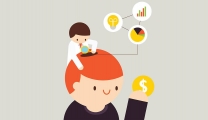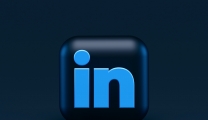What Is A Freemium Model?
Typically, a freemium model works best for subscription-based products and websites, but it can be effective for any digital product.
The premise of this model is to offer a free yet limited version of the product to a customer.
This concept is similar to a free trial, except the user has access to the free product forever, not just for a short period.
The idea of a freemium model is to entice the user to buy the premium version of a product after testing the free one (hence the combination of the words free and premium).
The trick is to make the limited version useful but not so valuable that the customer doesn’t need to upgrade.
Freemium models are quite popular these days, utilized by sites like Spotify, MailChimp, and Evernote.
Just over half of app developers (54%) use this model, and 33% of apps make the most money through the freemium system.
What Is An Ideal Freemium Conversion Rate?
The “ideal” conversion rate can depend on a few factors.
If you’re looking at the average, it falls between 2% to 5% percent of users.
Some companies, like Spotify, have a much higher conversion rate (46% in 2019), but they’re often outliers.
Defining the best freemium conversion rate
For your business, you’ll have to consider these three points to determine the ideal rate:
1. Business Model
Do you generate most of your revenue from monthly subscriptions?
If so, you’ll want a higher conversion rate. If the premium upgrade is a one-time purchase, a relatively low rate is okay.
2. User Base
Modern marketing methods rely on targeting specific niches.
Rather than selling to everyone, most companies focus on a few key demographics.
One advantage of a freemium model is the ability to raise brand awareness.
If your audience is massive, you should expect a lower conversion rate. If you’re appealing to a small niche, you want a higher rate.
3. Support Costs
One disadvantage of a freemium model is that your support team has to work with free users and paid ones.
So, the more freemium customers you have, the more time and resources you have to devote to them.
If your costs are high (or increasing with new users), you need to improve your conversion rate to keep up.
Overall, you should aim for a modest conversion rate of about 2% or 3% percent.
Over time, you can analyze data and assess your growth potential so you can determine whether you should go higher or stay the same.
How To Optimize Your Freemium Model
To ensure that you get the best freemium conversion rate possible, you need to understand the driving factors behind those conversions.

Why are users upgrading to a premium version? Once they upgrade, do they continue to pay the higher price?
Let’s take a closer look at some of the best ways to optimize your freemium model.
Step one: create a killer product
One of the primary reasons Spotify has such a high conversion rate is that it has a product that everyone likes.
While Spotify isn’t the only music streaming service in the industry, it has some of the best features and plenty of name recognition.
Users appreciate the easy-to-use dashboard, curated playlists, and the ability to discover new music.
If you want to encourage freemium users to upgrade, you need to have something worth paying for.
➜ What problem does your product solve?
➜ What can you provide that your competitors can’t?
➜ What keeps your users coming back over and over again?
Fortunately, a freemium model gives you a lot of insight into user data, which you can analyze to create a better product.
Pay attention to the features that your customers are using the most (and least).
By refining your software, you can develop a cycle of continuous improvement. Eventually, you’ll eliminate any redundancies and deliver a compelling product that users love.
Step two: create a compelling reason to upgrade
While Spotify’s free version gives users full access to its music library, they have to put up with ads.
Free users are constantly bombarded with advertisements in the middle of their playlists, spurring them to upgrade.
Plus, Spotify itself is pretty affordable at just $10 per month.
We’re positive that if Spotify doubled its subscription price, it would immediately shed many premium users. As it stands, almost everyone can afford ten bucks.
You have to provide the same level of encouragement to your users when developing your freemium model.
They need to see the immediate value of upgrading. Otherwise, there’s no reason to pay for a product they get for free.
It can be tricky to figure out a solution, though.
On the one hand, you need to provide enough usability with the free version to get more people to sign up.
On the other hand, you need to limit those features, so users are compelled to switch.
It’s a tough balancing act and not one that many companies achieve successfully.
Step three: remove friction to upgrade
One reason why many people might not upgrade is that it’s too much work to switch, or the price is too high.

Some common sticking points for users can be:
Complex Onboarding Process
Do users have to enter a lot of information or set up a lengthy profile? Do they need constant support in the beginning to figure out how to use the premium version?
Unbalanced Cost vs. Value
As a rule, customers will pay virtually any price as long as they see the value in it. If your premium product doesn’t offer much more value yet costs a lot, few people will switch.
On the flip side, if you provide tons of features for a relatively low price, you can likely get more conversions.
Subscription vs. One-Time Fee
For some, a monthly subscription may seem like too much of a commitment. Even if they can cancel at any time, users might not see a need for your product down the line.
While some companies can switch from a single payment to a subscription model (think Adobe), not everyone has success.
What you might notice is that more people convert if they only have to pay once. That said, you need to figure out how that will affect your bottom line.
Customer Service
In many cases, users like having personalized attention. If you have an unresponsive customer service team, people won’t want to switch.
However, if you take care of free users, they might be more inclined to upgrade, knowing that they can get help whenever they need it.
Step four: promote upgrades early and often
Most of the ads played for free Spotify users are endorsements for the paid version of the app.
This tactic works two ways:
➜ First, it keeps reminding users to upgrade.
➜ Second, it means that Spotify doesn’t have to share ad space with other companies. This helps reduce down marketing costs.
Your freemium model should take a similar approach.
If you don’t remind your free customers often to switch, they’re less likely to consider it.
During these reminders, be sure to highlight the benefits they’ll receive by upgrading.
For example, let’s say that your free users have a small amount of storage space.
Once they reach their limit, you can deliver a push notification to upgrade. As long as you’ve removed any friction, you can likely get an immediate response.












Replies to This Discussion